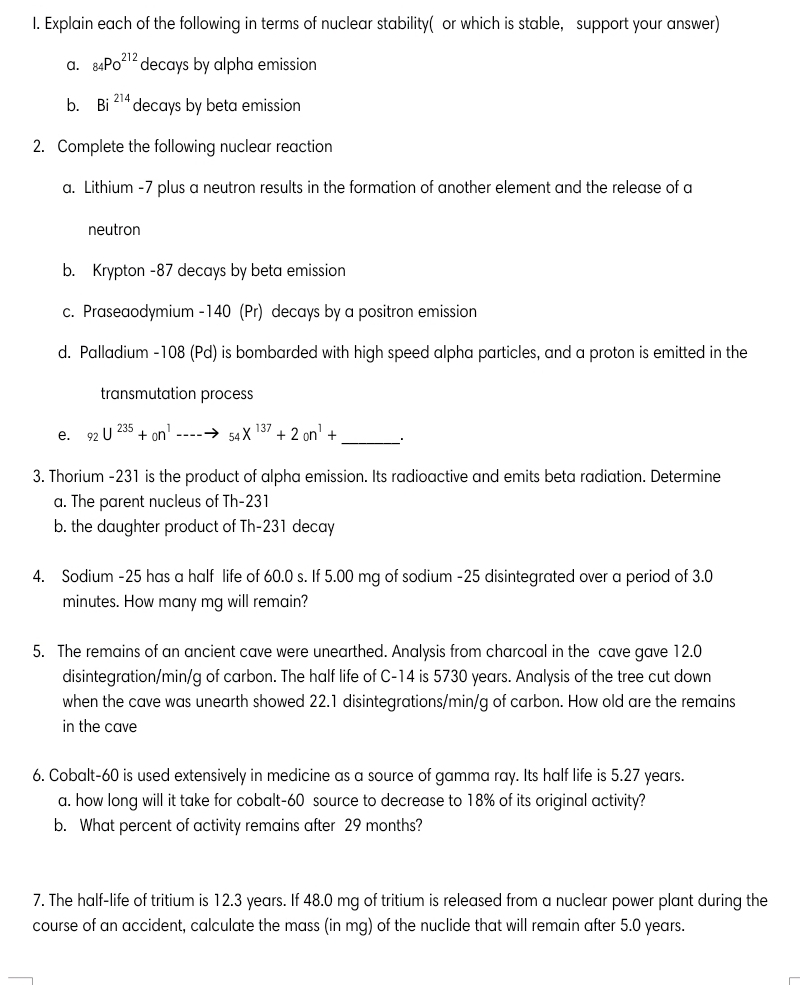Explain each of the following in terms of nuclear stability( or which is stable, support your answer) a. 84Po212 decays by alpha emission b. Bi 214 decays by beta emission
Explain each of the following in terms of nuclear stability( or which is stable, support your answer) a. 84Po212 decays by alpha emission b. Bi 214 decays by beta emission
Chemistry for Engineering Students
4th Edition
ISBN:9781337398909
Author:Lawrence S. Brown, Tom Holme
Publisher:Lawrence S. Brown, Tom Holme
Chapter14: Nuclear Chemistry
Section: Chapter Questions
Problem 14.36PAE
Related questions
Question
Explain each of the following in terms of nuclear stability( or which is stable, support your answer)
a. 84Po212 decays by alpha emission
b. Bi 214 decays by beta emission

Transcribed Image Text:I. Explain each of the following in terms of nuclear stability( or which is stable, support your answer)
a. 84PO12 decays by alpha emission
b. Bi
¡ 214
decays by beta emission
2. Complete the following nuclear reaction
a. Lithium -7 plus a neutron results in the formation of another element and the release of a
neutron
b. Krypton -87 decays by beta emission
c. Praseaodymium -140 (Pr) decays by a positron emission
d. Palladium -108 (Pd) is bombarded with high speed alpha particles, and a proton is emitted in the
transmutation process
е. 92 U
235
+ on' ----→ 54 X
137
+ 2 on'
3. Thorium -231 is the product of alpha emission. Its radioactive and emits beta radiation. Determine
a. The parent nucleus of Th-231
b. the daughter product of Th-231 decay
4. Sodium -25 has a half life of 60.0 s. If 5.00 mg of sodium -25 disintegrated over a period of 3.0
minutes. How many mg will remain?
5. The remains of an ancient cave were unearthed. Analysis from charcoal in the cave gave 12.0
disintegration/min/g of carbon. The half life of C-14 is 5730 years. Analysis of the tree cut down
when the cave was unearth showed 22.1 disintegrations/min/g of carbon. How old are the remains
in the cave
6. Cobalt-60 is used extensively in medicine as a source of gamma ray. Its half life is 5.27 years.
a. how long will it take for cobalt-60 source to decrease to 18% of its original activity?
b. What percent of activity remains after 29 months?
7. The half-life of tritium is 12.3 years. If 48.0 mg of tritium is released from a nuclear power plant during the
course of an accident, calculate the mass (in mg) of the nuclide that will remain after 5.0 years.
Expert Solution
This question has been solved!
Explore an expertly crafted, step-by-step solution for a thorough understanding of key concepts.
This is a popular solution!
Trending now
This is a popular solution!
Step by step
Solved in 2 steps

Knowledge Booster
Learn more about
Need a deep-dive on the concept behind this application? Look no further. Learn more about this topic, chemistry and related others by exploring similar questions and additional content below.Recommended textbooks for you

Chemistry for Engineering Students
Chemistry
ISBN:
9781337398909
Author:
Lawrence S. Brown, Tom Holme
Publisher:
Cengage Learning

Chemistry: The Molecular Science
Chemistry
ISBN:
9781285199047
Author:
John W. Moore, Conrad L. Stanitski
Publisher:
Cengage Learning


Chemistry for Engineering Students
Chemistry
ISBN:
9781337398909
Author:
Lawrence S. Brown, Tom Holme
Publisher:
Cengage Learning

Chemistry: The Molecular Science
Chemistry
ISBN:
9781285199047
Author:
John W. Moore, Conrad L. Stanitski
Publisher:
Cengage Learning


Chemistry
Chemistry
ISBN:
9781305957404
Author:
Steven S. Zumdahl, Susan A. Zumdahl, Donald J. DeCoste
Publisher:
Cengage Learning

Chemistry: An Atoms First Approach
Chemistry
ISBN:
9781305079243
Author:
Steven S. Zumdahl, Susan A. Zumdahl
Publisher:
Cengage Learning

Chemistry: Matter and Change
Chemistry
ISBN:
9780078746376
Author:
Dinah Zike, Laurel Dingrando, Nicholas Hainen, Cheryl Wistrom
Publisher:
Glencoe/McGraw-Hill School Pub Co